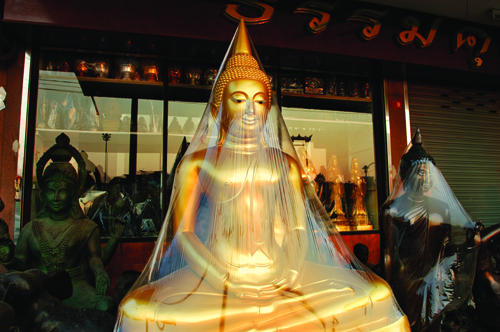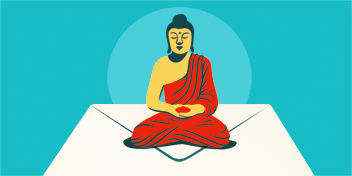My previous blog post reflecting on Gish Jen’s new book Tiger Writing: Art, Culture, and the Independent Self, generated quite a bit of discussion. Some respondents dismissed as mere “personal observation” the claim that people from Western and Eastern cultures tend toward different types of self-construal. Others considered such generalizations as an Eastern “collectivist self” vs. a Western “individualist self” stereotypical, unhelpful, or completely irrelevant. One reader, while acknowledging that cultural differences of self-construal were “well known and not new,” stated flatly that such differences are “not important as far as awakening is concerned,” while another worried that they were so important the dharma transmission to the West must be doomed—since the dharma is so deeply rooted in Asian contexts, how could it possibly exist elsewhere?
So I wanted to address these concerns.
 First I want to set facts straight. It is well accepted among many scholars across academic fields that self-identity is construed differently across cultures and over time. While Gish Jen speaks for the most part from her own experience, she also cites several empirical studies by cross-cultural psychologists. The points she makes about differences between Western “individualism” and Asian “collectivism” are also affirmed by a large body of anthropological and historical research. Western Buddhists are largely unaware of this scholarship and we have yet to explore its implications for the transmission of the dharma to the West.
First I want to set facts straight. It is well accepted among many scholars across academic fields that self-identity is construed differently across cultures and over time. While Gish Jen speaks for the most part from her own experience, she also cites several empirical studies by cross-cultural psychologists. The points she makes about differences between Western “individualism” and Asian “collectivism” are also affirmed by a large body of anthropological and historical research. Western Buddhists are largely unaware of this scholarship and we have yet to explore its implications for the transmission of the dharma to the West.
For those interested in reading some of the research on this topic, a good starting place is the anthology Culture and Self, edited by Anthony J. Marella, George Devos, and Francis L.K. Hsu, which includes essays by a range of anthropologists who explore various ways subjectivity is constituted in specific cultural contexts. For insight into how the Western self-construal has changed over time, read Charles Taylor’s Sources of the Self—The Making of the Modern Identity. For more on why these types of differences matter to Western Buddhists, see my Tricycle article “What’s at Stake as the Dharma Goes Modern?” from the Fall 2012 issue.
Second, there is an important difference between acknowledging valid cultural differences and stereotyping. Acknowledgments of cultural difference admittedly are too often appropriated by prejudice, but they need not be. Gish Jen put this point quite well:
Before I begin, I’d like to say that with this, as with all discussions involving cultural difference, I am aware of the danger of stereotyping. “Simplistic and overexaggerated beliefs about a group, generally acquired second-hand and resistant to change,” as sociologist Martin M. Marger put it, are obviously to be roundly condemned and absolutely avoided. I am also aware, though, that fear of stereotyping has sometimes led to a discomfort with any assertion of cultural difference, no matter how thoroughly accepted by psychologists or how firmly grounded in research.
To be unaware of (or outright deny) what is factually true is a kind of blindness. Perhaps in the case of the blog post respondents the blindness is well-meaning—a kind of “don’t-want-to-go-there” resistance to walking down a road known to be perilously vulnerable to sabotage by prejudice, power, and hatred. But when we don’t pay conscious attention to differences, we tend to see others through our own filters, construct them in our image, and believe—falsely—that we see them accurately.
Gish Jen again:
In his 1932 classic, Remembering, psychologist Frederic C. Bartlett describes an experiment in which British test subjects were asked to repeatedly retell a Native American ghost tale after intervals that ranged from a matter of minutes to a matter of months. The results were revealing: with each new round, the subjects misremembered yet more, unconsciously editing and reshaping the tale—changing seal hunting to “fishing,” for example, and removing and altering what seemed to them weird story elements—until it had become something no longer Native American at all—until it had become, in fact, pretty bloody British.
You might think that’s just what does and should happen. The dharma as seal-hunting-in-Alaska comes to the West as fishing-on-the-Thames. But what if there are important elements of seal hunting that gave that ghost tale its meaning—such as the danger involved, the taking of risk, or the need for courage—that are utterly left out of a fishing picnic on the river? Would that be “translating” the dharma or would that be “reimagining” it?
The reader who wrote that differences in self construal between Asians and Westerners “are not important as far as awakening is concerned” was in one particular sense correct: the dharma teaches that what ultimately binds us in samsara is clinging to any self as truly existent—hungry ghost, animal, human-interdependent, human-independent—the type of self isn’t the problem, our clinging to it is. From this perspective, there is nothing exceptional about Westerners vis-à-vis Asians; we’re equally bound, and we can equally become free. But these differences are critically important to our awakening in quite another sense.
Although all societies construct delusions in deep and hidden and stubborn ways, cultures have specific delusions that are particularly recalcitrant. The dharma in this sense is not one-size-fits-all. It must be interpreted and applied to its specific context. The real potential trouble spots in translating dharma teachings and practices to the West occur at those cross points where our culture is not only different from Asian culture, but different in an exactly-upside-down-and-backwards sort of way. Consider the following from the well-known sociologist of religion Robert Bellah. (For his complete interview with Tricycle’s Andrew Cooper, see “The Future of Religion”.)
Zen Buddhism began in Japan at a time when strong social structures hemmed in individuals on every side. The family you were born to determined most of your life-chances. Buddhism was a way to step outside these constricting structures. Becoming a monk was called shukke, literally, “leaving the family.” We live in an almost completely opposite kind of society, where all institutions are weak and the family is in shambles. You don’t need Buddhism to “leave the family.” To emphasize primarily the individualistic side of Buddhism (especially Zen) in America is only to contribute to our pathology, not ameliorate it.
Liberation requires going against the grain of our pattern of clinging, no matter what that pattern is. If our self-construct is highly individualistic, then against the grain would be toward interdependence and mutual support; if the sense is highly enmeshed in social roles, then against the grain would be toward autonomy. But if the prevailing construct is individualistic and the teachings we employ focus on autonomy, then they don’t push against the grain at all; they in fact reinforce the very problem Buddhism seeks to help us find a way out of.
Westerners can and need to make the dharma authentically our own. That is precisely the point of looking closely at cultural difference—to understand what the teachings mean in the culture we are taking them from so that we can translate that meaning accurately into a different context. The better we understand what differences are at play, the more skill we will have in navigating them. But if we simply adopt Buddhist teachings and practices without paying attention to the cultural contexts that have framed them for millennia, we risk understanding those teachings in a manner diametrically opposed to their intent. Our meditation might then reinforce the scaffolding of our suffering rather than destroy it. In what sense could we then consider our practice Buddhist?
With support from the John Templeton Foundation, Tricycle’s Buddhism and Modernity project is initiating a conversation between Buddhists and leading thinkers across the humanities and social sciences. Tricycle is exploring how perspectives drawn from critical theory about the nature of religion, culture, science, and secularism can shed light on unexamined assumptions shaping the transmission of Buddhism to modernity. This project offers Western Buddhists new ways of thinking about their spiritual experiences by demonstrating how reason can be used as a tool to open up—rather than shut down—access to traditional faith.
Photograph by Alison Wright, originally printed in Tricycle’s Winter 2011 “Living Buddhism,” by Dharmavidya David Brazier. Read it here.
Thank you for subscribing to Tricycle! As a nonprofit, we depend on readers like you to keep Buddhist teachings and practices widely available.
